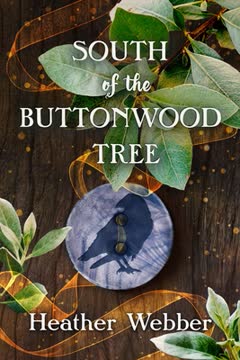Plot Summary
Trouble in the Wind
In Buttonwood, Alabama, Blue Bishop senses trouble in the air—a feeling she knows well as the last of a family infamous for bad luck and worse choices. Blue, a children's book author and illustrator, is determined to avoid the Bishop curse and build a better life, especially as she dreams of motherhood. Her only family is her younger sister Persy, and their surrogate grandparents, Marlo and Moe, who run the local children's bookshop. Blue's life is shaped by the town's long memory and her own sense of being an outsider, but she clings to hope, guided by the mysterious Buttonwood Tree, a local legend that dispenses advice on wooden buttons. When Blue finds a newborn baby abandoned under the Buttonwood Tree, with a button instructing her to care for the child, her life—and the town—are set on a new, unpredictable course.
The Baby Under the Tree
Blue's discovery of the baby, whom she names Flora, sends shockwaves through Buttonwood. The town's gossip mill churns, and Blue is granted emergency guardianship, but the baby's origins are a mystery. The Buttonwood Tree's message—"Give the baby to Blue Bishop"—carries the weight of legend, and Blue is both elated and terrified at the prospect of motherhood. Meanwhile, Sarah Grace, a local real estate entrepreneur with her own tangled family history, is drawn into the drama as her mother, Ginny, schemes to claim the baby for their family. The baby's arrival stirs up old rivalries, secrets, and the town's deep-seated prejudices, especially against the Bishop name.
Secrets in the Bishop House
As Blue juggles caring for Flora and her work at the bookshop, Sarah Grace inspects the dilapidated Bishop farmhouse, hoping to buy and restore it. The house, like its former inhabitants, is full of sorrow and secrets. Sarah Grace's own marriage is crumbling, and her longing for a child is complicated by her husband's infidelity and her mother's relentless pursuit of perfection. The farmhouse becomes a symbol of both the past's pain and the possibility of redemption. Meanwhile, Blue's connection to the house and her family's history grows more complicated as she faces the prospect of returning there to set up her art studio, a requirement for keeping Flora.
The Buttonwood Tree's Wisdom
The Buttonwood Tree stands at the heart of Buttonwood's folklore, believed to offer guidance—at a price. Blue, Sarah Grace, and others seek its counsel, each receiving cryptic advice on wooden buttons. The tree's legend is woven into the town's fabric, shaping decisions and destinies. Blue's button urges her to risk love, while Sarah Grace's button tells her to "follow your heart to find your happiness." The tree's wisdom is both a comfort and a curse, as ignoring its advice is said to bring lifelong unhappiness. The magical realism of the tree, the wind, and the crow that leads seekers to it, infuses the story with a sense of fate and the possibility of transformation.
The Ties That Bind
Blue's struggle to be accepted as a mother is complicated by the town's judgment of her family. The Bishop name is synonymous with trouble, and Blue is haunted by her relatives' criminal pasts and tragic ends. Sarah Grace, too, is trapped by her family's expectations and secrets, especially her mother's vendetta against the Bishops. Both women are shaped by the legacies they inherit and the choices they make to protect those they love. As Blue fights to keep Flora, and Sarah Grace faces the collapse of her marriage, both must confront the true meaning of family and the possibility of forgiveness.
Flora's Fate
The question of who should raise Flora becomes a battleground, with Blue's guardianship challenged by the powerful Landreneau family. The town's opinions are divided, and Blue is forced to prove her worthiness as a mother, not just to the authorities but to herself. The community's support—or lack thereof—becomes crucial, and Blue is urged to become a "thread in the fabric of the community." Meanwhile, Sarah Grace's own family fractures under the weight of secrets, and her cousin Kebbie's hidden pregnancy brings new complications. The fate of Flora becomes a test of love, loyalty, and the courage to do what's right.
The Weight of Reputation
Buttonwood's long memory and sharp tongue make life difficult for anyone with a tarnished name. Blue faces prejudice at every turn, from the town's matriarchs to the legal system. Stories of her family's misdeeds are retold and exaggerated, and even her acts of kindness are viewed with suspicion. Yet, as Blue's true character is revealed through her actions, some townsfolk begin to reconsider their judgments. The story explores how reputation can be both a prison and a challenge to rise above, and how the courage to be oneself can slowly change even the most entrenched opinions.
Hidden Mothers, Hidden Daughters
As the investigation into Flora's origins deepens, DNA tests reveal shocking truths: Blue is not who she thought she was. She is not Twyla's daughter, but the child of Mac Bishop and Ginny Cabot—making her and Sarah Grace sisters. The revelation that Blue was stolen as a baby and raised by the Bishops upends both families and forces a reckoning with the past. Meanwhile, Kebbie's secret—that she is Flora's birth mother—comes to light only when she falls gravely ill. The story explores the pain and healing that come from uncovering hidden truths, and the ways in which love can transcend blood and history.
The Truth in the Blood
The results of the DNA tests ripple through Buttonwood, exposing long-buried secrets and reshaping relationships. Blue and Sarah Grace must come to terms with their true parentage, and Ginny is forced to confront the consequences of her choices and the lies she told to protect herself. The revelation that Mary Eliza Wheeler, the town's most judgmental woman, was the one who stole Blue as a baby adds another layer of complexity and irony. The truth, once revealed, brings both pain and the possibility of healing, as the characters grapple with what it means to be family.
Forgiveness and Family
With the truth out in the open, the characters must choose whether to cling to old wounds or seek forgiveness. Blue, Sarah Grace, and Ginny each face their own reckonings, learning that perfection is an illusion and that love is found in acceptance and vulnerability. The community, too, begins to change, as old enemies become allies and new bonds are formed. The healing power of forgiveness is shown not as a single act, but as an ongoing process that requires courage, humility, and the willingness to see others—and oneself—anew.
The Healing Moon
Marlo, Blue's surrogate grandmother, possesses a quiet magic—she can heal with the light of the moon. As her beloved Moe's dementia worsens, Marlo faces the impossible choice of using her remaining magic to save him or to help Kebbie, whose life hangs in the balance. In the end, Marlo chooses to save Kebbie, letting Moe go with dignity. The story honors the sacrifices made in the name of love, and the ways in which the gifts we give—whether magical or mundane—can ripple outward, changing lives in ways we may never fully understand.
A New Kind of Home
As the dust settles, Blue and Sarah Grace find themselves not just sisters, but friends and allies. The Bishop farmhouse is restored, not just physically but emotionally, becoming a place of welcome and warmth. Flora's adoption is finalized, and the extended family—by blood and by choice—gathers to celebrate new beginnings. The story affirms that home is not just a place, but a web of relationships, memories, and hopes. The characters learn that true belonging comes from embracing both the light and the shadows of their histories.
Thanksgiving Threads
On Thanksgiving, the families and friends of Buttonwood gather in a spirit of reconciliation and hope. Old grievances are set aside, and new traditions are born. The table is surrounded by those who have been enemies, rivals, and strangers, now united by the threads of forgiveness, love, and shared history. The Buttonwood Tree, the wind, and the crow watch over them, silent witnesses to the power of truth, the magic of second chances, and the enduring strength of community. The story ends with a sense of peace, possibility, and the knowledge that, south of the Buttonwood Tree, anything is possible.
Characters
Blue Bishop
Blue is the protagonist, a gentle, creative soul marked by her family's troubled reputation. Orphaned young, she is fiercely protective of her sister Persy and longs for a family of her own. Blue's gift for finding lost things—literal and metaphorical—mirrors her own search for identity and acceptance. Her journey is one of self-discovery, as she learns that her true worth is not defined by her family's past but by her own choices. Blue's arc is one of transformation: from outsider to beloved mother, from secret daughter to cherished sister, and from self-doubt to self-acceptance.
Sarah Grace Landreneau
Sarah Grace is Blue's foil and, ultimately, her sister. Raised in a family obsessed with appearances, she is torn between duty and desire, especially as her marriage unravels and her longing for a child intensifies. Sarah Grace's journey is about breaking free from the prison of perfection and learning to follow her heart, even when it leads her into the unknown. Her relationship with Blue evolves from wary acquaintance to deep kinship, and her courage in facing the truth inspires those around her to do the same.
Flora
Flora, the foundling baby, is the story's beating heart. Her mysterious arrival under the Buttonwood Tree sets the plot in motion and forces the characters to confront their deepest fears and desires. Flora is both a literal child and a symbol of new beginnings, the possibility of healing old wounds, and the hope that love can triumph over history. Her presence brings out the best in those around her, uniting a fractured community and revealing the hidden strengths of her adoptive and birth families.
Ginny Cabot Landreneau
Ginny is Sarah Grace's mother and, as it is revealed, Blue's biological mother. Driven by a need for control and a fear of scandal, Ginny's actions are both protective and destructive. Her vendetta against the Bishops is rooted in pain and loss, and her journey is one of reckoning with the consequences of her choices. Ginny's arc is about learning to let go of perfection, to forgive herself and others, and to embrace the messy, beautiful reality of family.
Marlo Allemand
Marlo is the emotional anchor for Blue and Persy, offering unconditional love and support. Her magical ability to heal with moonlight is a metaphor for the power of compassion and sacrifice. Marlo's struggle to let go of her ailing husband, Moe, and her decision to use her magic to save Kebbie, highlight the costs and rewards of loving deeply. She embodies the wisdom of the Buttonwood Tree and the strength of chosen family.
Moe Allemand
Moe, Marlo's husband, is a beloved figure whose dementia is both a source of sorrow and a reminder of the fragility of life. His presence is a touchstone for Blue and the community, and his eventual passing is handled with grace and love. Moe's legacy lives on in the stories he told, the kindness he showed, and the family he helped create.
Persy Bishop
Persy is Blue's younger sister, raised by Blue after their parents' deaths. Outgoing and well-liked, Persy is both a source of comfort and a catalyst for change. Her involvement in Kebbie's secret and her willingness to risk her own reputation for a friend reveal her deep loyalty and courage. Persy's arc is about learning to forgive herself and to accept the complexities of love and family.
Kebbie Hastings
Kebbie, Sarah Grace's cousin, is Flora's birth mother. Her secret pregnancy and subsequent illness force her to confront her own fears and the consequences of hiding the truth. Kebbie's journey is one of vulnerability and bravery, as she chooses to give Flora a better life and faces the judgment of her family and community. Her recovery and ongoing relationship with Flora and Blue are testaments to the power of forgiveness and the possibility of new beginnings.
Henry Dalton
Henry, the new owner of the bookshop and Oleta Blackstock's grandson, is a gentle, thoughtful man who becomes Blue's love interest. His outsider status allows him to see Buttonwood—and Blue—with fresh eyes, and his willingness to challenge his own family's prejudices mirrors the story's larger themes. Henry's relationship with Blue is a source of healing and joy, and his presence signals the possibility of change and acceptance in Buttonwood.
Shep Wheeler
Shep, the local police investigator and Sarah Grace's former (and future) love, is a man marked by his own family's darkness. His mother, Mary Eliza, is revealed as the one who stole Blue as a baby, and Shep's struggle to reconcile his love for his mother with the harm she caused is a central emotional thread. Shep's integrity, compassion, and willingness to face the truth make him a key figure in the story's resolution and a symbol of the possibility of breaking cycles of pain.
Plot Devices
The Buttonwood Tree and Its Buttons
The Buttonwood Tree is the story's central symbol and plot device, blending Southern folklore with magical realism. Its buttons dispense cryptic advice that shapes the characters' choices and fates, serving as both a comfort and a challenge. The tree's legend—of a woman transformed by grief, a guiding crow, and the risk of ignoring its wisdom—infuses the narrative with a sense of destiny and the supernatural. The buttons' messages are both literal plot drivers (e.g., "Give the baby to Blue Bishop") and metaphors for the characters' internal journeys. The tree's presence weaves together the themes of fate, free will, and the cost of ignoring one's heart.
Interwoven Narratives and Multiple Perspectives
The novel alternates between Blue's and Sarah Grace's perspectives, allowing readers to see the same events through different lenses. This structure highlights the parallels and contrasts between the two women—their longing for family, their struggles with reputation, and their quests for belonging. The use of community voices—judges, shopkeepers, and townsfolk—adds depth and texture, creating a chorus of opinions that both challenge and support the protagonists. The narrative's layering of secrets, revelations, and shifting alliances keeps the plot dynamic and emotionally resonant.
DNA Testing and the Unraveling of Identity
The use of DNA testing as a plot device brings the story's secrets into the light, forcing characters to confront the realities of their origins and relationships. The tests serve as both a literal and symbolic means of uncovering hidden truths, challenging assumptions about family, and redefining what it means to belong. The revelations that Blue and Sarah Grace are sisters, and that Blue was stolen as a baby, are turning points that reshape the narrative and drive the characters toward forgiveness and healing.
Magical Realism and the Healing Moon
Marlo's ability to heal with moonlight adds a layer of magical realism that underscores the story's themes of compassion, sacrifice, and the limits of human power. The magic is quiet, domestic, and deeply tied to the rhythms of nature and community. It serves as both a comfort and a source of tension, as Marlo must choose how to use her dwindling magic and when to let go. The healing moon is a metaphor for the ways in which love can mend what is broken, even when it cannot prevent loss.
The Power of Community and Chosen Family
The story's resolution hinges on the willingness of the community—and the characters themselves—to move beyond judgment and embrace forgiveness. The transformation of enemies into allies, the weaving of new family ties, and the celebration of difference are all made possible by acts of kindness, courage, and vulnerability. The plot device of the Thanksgiving gathering, with its mix of old grudges and new beginnings, serves as a microcosm of the novel's message: that true belonging is found not in perfection, but in the messy, beautiful work of loving and being loved.
Analysis
Heather Webber's South of the Buttonwood Tree is a luminous exploration of family, identity, and the redemptive power of truth and forgiveness. Set in a small Southern town steeped in legend and prejudice, the novel uses magical realism—the Buttonwood Tree, the guiding wind, the healing moon—to illuminate the very real struggles of its characters. At its heart, the book is about the courage to break cycles of pain: to risk love after loss, to claim one's place in a world that says you don't belong, to forgive both others and oneself. The story's intricate plot—full of secrets, mistaken identities, and unexpected kinships—serves as a metaphor for the ways in which we are all shaped by the stories we inherit and the choices we make. Webber's message is clear: family is not defined by blood alone, but by the threads of love, sacrifice, and acceptance that we weave together. The novel invites readers to consider the cost of silence, the necessity of community, and the magic that can be found in the most ordinary acts of kindness. In the end, South of the Buttonwood Tree is a celebration of second chances, the healing power of truth, and the enduring hope that, no matter how lost we may feel, we can always find our way home.
Last updated:
Review Summary
South of the Buttonwood Tree is a heartwarming Southern tale with magical realism elements. Set in Buttonwood, Alabama, it follows Blue Bishop, who finds an abandoned baby near a mystical tree. The story explores family secrets, forgiveness, and small-town dynamics. Readers praised Webber's vivid characters, enchanting writing style, and the blend of magic and reality. Many found it captivating and emotionally resonant, comparing it favorably to Sarah Addison Allen's works. While some felt it was predictable, most reviewers highly recommended it for its charm and uplifting narrative.
Similar Books
Download PDF
Download EPUB
.epub digital book format is ideal for reading ebooks on phones, tablets, and e-readers.









